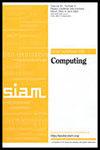A Probabilistic Approach to the Dichotomy Problem
IF 1.6
3区 计算机科学
Q3 COMPUTER SCIENCE, THEORY & METHODS
引用次数: 15
Abstract
Let ${\mathcal R}(n,k)$ denote the random $k$-ary relation defined on the set $[n]=\{1,2,\dots,n\}$. We show that the probability that $([n], {\mathcal R}(n,k))$ is projective tends to one, as either $n$ or $k$ tends to infinity. This result implies that for most relational systems $(B,{{\underline{R}}})$ the ${{\textrm{CSP}}}(B,{{\underline{R}}})$ problem is NP-complete (and thus that the dichotomy conjecture holds with probability 1), and confirms a conjecture of Rosenberg [I. G. Rosenberg, Rocky Mountain J. Math., 3 (1973), pp. 631-639].二分类问题的概率方法
设${\mathcal R}(n,k)$表示在集合$[n]=\{1,2,\dots,n\}$上定义的随机的$k$ -ary关系。我们证明$([n], {\mathcal R}(n,k))$是射影的概率趋向于1,因为$n$或$k$趋向于无穷大。这一结果表明,对于大多数关系系统$(B,{{\underline{R}}})$, ${{\textrm{CSP}}}(B,{{\underline{R}}})$问题是np完全的(因此二分猜想以概率1成立),并证实了Rosenberg [I]的一个猜想。罗基山J.数学。, 3(1973),第631-639页。
本文章由计算机程序翻译,如有差异,请以英文原文为准。
求助全文
约1分钟内获得全文
求助全文
来源期刊

SIAM Journal on Computing
工程技术-计算机:理论方法
CiteScore
4.60
自引率
0.00%
发文量
68
审稿时长
6-12 weeks
期刊介绍:
The SIAM Journal on Computing aims to provide coverage of the most significant work going on in the mathematical and formal aspects of computer science and nonnumerical computing. Submissions must be clearly written and make a significant technical contribution. Topics include but are not limited to analysis and design of algorithms, algorithmic game theory, data structures, computational complexity, computational algebra, computational aspects of combinatorics and graph theory, computational biology, computational geometry, computational robotics, the mathematical aspects of programming languages, artificial intelligence, computational learning, databases, information retrieval, cryptography, networks, distributed computing, parallel algorithms, and computer architecture.
 求助内容:
求助内容: 应助结果提醒方式:
应助结果提醒方式:


